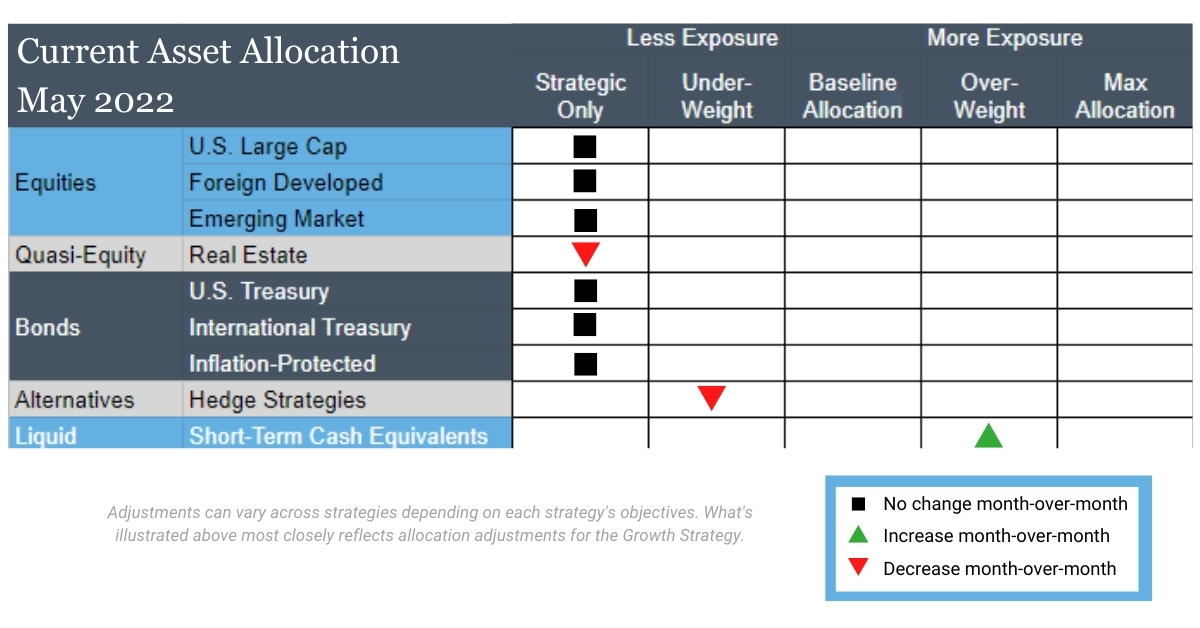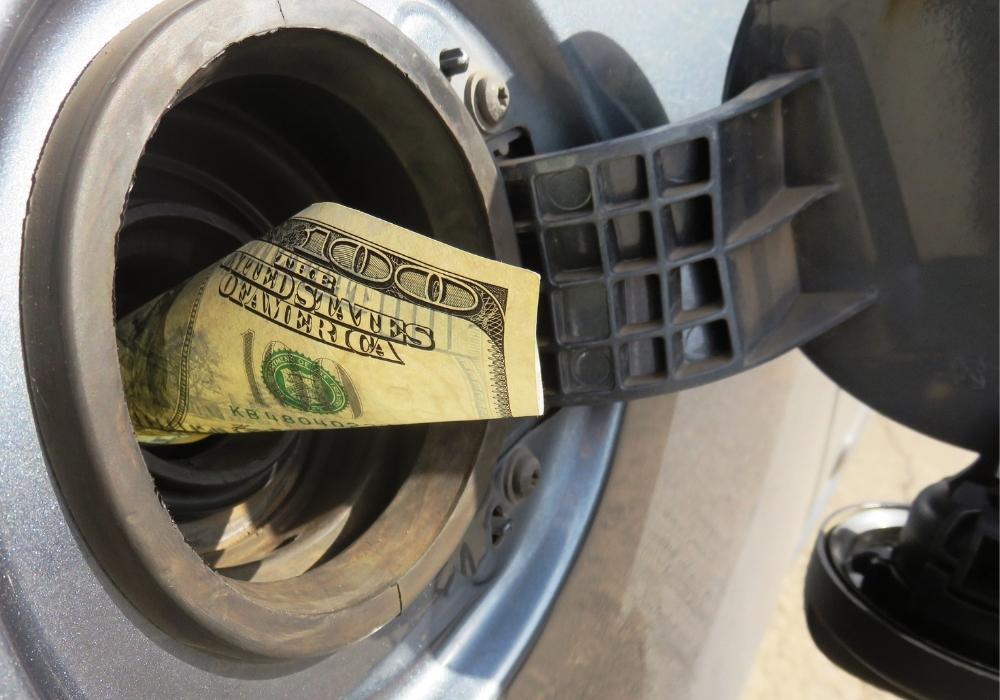June 2022 Monthly Investment Update
“The best preparation for the future is the present well seen to, and the last duty done.” —George Macdonald
In the book “Extreme Ownership,” Jocko Willink and Leif Babin outline the leadership principles the two men learned during their military service and how they found these tenants to be universal and adaptable to everyday life. When discussing the execution of a plan in the face of intense stress and uncertainty, the two former Navy Seal officers assert, “A particularly effective means to help Prioritize and Execute under pressure is to stay at least a step or two ahead of real-time problems. Through careful contingency planning, a leader can anticipate likely challenges that could arise during execution and map out an effective response to those challenges before they happen.”
We consistently preach about the value of having a plan. In market environments where uncertainty and fear are rampant, the value of flawless execution is paramount, but the benefits of staying disciplined often remaining invisible until after the fact. For us, reacting to the current market environment through a systematic investing process IS our contingency plan for anticipating challenges before they happen, such as catastrophic losses in client accounts due to large drawdowns.
In this month’s Note, we discuss the near-term costs and potential long-term benefits associated with preparation. When given evidence that a disaster may be on the horizon, it can be annoying and time-intensive to get ready. But those near-term costs seem trivial compared to the catastrophic loss that can come with being unprepared for the worst-case scenario. The point is this: You never know the severity BEFORE the event happens, but ignoring the data ahead of time can sometimes prove disastrous.
But first, here’s a summary of our take on what transpired in the markets in May.

U.S. Equities
Exposure will not change, as both the intermediate- and long-term timeframes remain in downtrends.
Inflation-Protected Bonds
Exposure will not change and is at its minimum due to downtrends across both timeframes.
Intl Equities
Exposure will not change, as both foreign developed and emerging markets remain in downtrends across both timeframes.
Alternatives
Exposure will decrease, as gold moves into an intermediate-term downtrend. The long-term trend remains positive.
U.S. & Intl Treasuries
Exposure will not change and is at its minimum allocation due to downtrends across both timeframes.
Real Estate
Exposure will decrease, as both the intermediate- and long-term timeframes go into downtrends.
Short-Term Fixed Income
Exposure will increase, as it takes on exposure from real estate, U.S. equities, foreign equities, and longer-duration fixed income.
Asset Level Overview
Equities & Real Estate
A new month meant new lows for U.S. stocks, reducing in the short-term whatever hope remained of establishing a near-term bottom. At their lows, domestic equities retraced to their Q1’21 level. While asset class level exposures were already at their minimum in our portfolios entering May, single stock portfolios will see additional decreases as we enter June, further reducing already low betas to stocks.
International equities have rebounded slightly in the second half of the month, but similar to U.S. stocks, made new lows in May. Trends across all timeframes we monitor continue pointing downward. As has been the case since the end of January, our portfolios continue to hold their minimum allocation to international equities.
After previously proving resilient to economic headwinds, real estate also experienced declines in May. In fact, this was the worst performing asset class within our portfolios. The monthly losses brought year-to-date declines in line with other poor performing equity sectors and moved it from uptrends to downtrends across both timeframes we monitor. The result is a move from baseline allocations to minimum allocations in all portfolios.
Fixed Income & Alternatives
For the moment, fixed income assets appear to have paused their freefall, stabilizing somewhat in May. This recalls what we suggested last month:
“…markets have a funny way of discounting expectations. When we least expect it, the market may fully price in future rate hikes and begin to stabilize. Either way, trends remain decidedly negative, so rather than try to catch that falling knife, we will remain at our minimum allocation to instruments of any duration.”
After sliding mid-month, gold has recovered but still managed to lose its intermediate-term uptrend. While the long-term uptrend remains intact, the change will be enough to cause reductions in our allocation in all portfolios.
3 Potential Catalysts for Trend Changes

Pain at the Pump:
Record high gas prices are starting to take a toll on Americans. The average price for a gallon of regular unleaded gas in the U.S. reached $4.60 on Thursday, a 51% increase from a year ago and a new all-time high. Prices rose above $4 a gallon, on average, in all 50 states last week.
Drawing Down Savings:
Consumer spending rose by a seasonally adjusted 0.9% last month, said the Commerce Department, beating estimates of a 0.7% rise in spending. However, the saving rate fell to 4.4%, the lowest in 14 years, from a downwardly revised 5% the prior month, suggesting that many Americans are tapping their savings to offset cost increases from high inflation.
Slowing but not Stopping:
The Federal Reserve’s preferred measure of inflation, the PCE (personal consumption expenditures price index), slowed its increase with a 0.2% increase in April, which translates into a 6.3% increase year-over-year down from the all-time high last month of a 6.6% increase.
Preparing for a Storm
“Better to have, and not need, than to need, and not have.”
—Franz Kafka
If you own property in a storm-prone area, or know someone who does, you likely understand that preparation is a necessary cost – but one that is nevertheless excruciating. If it’s a vacation home, then perhaps it involves driving hours, gathering the necessary supplies (usually when everyone else is trying to do the same), and spending time/energy getting everything into place. Often the forecast changes, and it turns out all that preparation was for nothing.
It’s somewhat understandable, then, when you hear stories of people who perform this ritual for years but one day decide it is unnecessary. It seems like it is precisely that time when the storm remains on track and devastates the property. After many months or even years, plus many calls with the insurance agent, they may rebuild and the cycle begins anew.
Unlike vacation homes, there is no insurance providing complete coverage for investment portfolios. In addition, forecasting technology for bear markets does not exist in the way it does for hurricanes. And yet, the average investor arguably views financial disaster preparation less seriously than coastal homeowners view storm preparation.
See, there is no way to know if an impending decline in stocks is of the category 1 variety or a catastrophic cat 5. Unlike a hurricane, where one can have an idea of the severity days in advance (and sometimes a week or more), financial markets provide little warning.
Therefore, it is our belief that one must carefully consider all the signs and have a plan to act accordingly. Systematic investing is tool for doing just that.
We recently have been talking about the anatomy of a bear market to help investors understand how we dissect market “downside.” Not all declines are created equal, and some level of damage is inevitable, but having a pre-determined plan for each of the three distinct phases allows you to put all the focus on execution when it is time to act. This year has provided an excellent real-time example.
After enjoying sunny skies and mostly perfect conditions in 2021, the clouds began to build in January. As a result, our systematic investing process took the first precautions by reducing exposure to the areas where damage was most imminent, such as international stocks. Notice we did not board up the house, nor did we ignore the situation altogether and go paddle-boarding. Think of our actions during this time as simply putting the beach umbrella down or securing the lawn furniture.
The next three months produced a steady decline in conditions, so much so that we again reduced exposure to riskier assets going into May. As we enter June, we have finished our preparation. The shutters are locked, and the sandbags are in place.
While we wait to see the outcome, we rest confidently in the words of Kafka quoted above. Our process is designed to keep our clients on track toward completing their goals. We believe further declines will not affect us as severely as they otherwise would if we had done nothing. And, if markets rebound, our process will rotate us back to allocations where we can participate in those gains.
It is our view that the odds of success in almost any pursuit – be health, wealth, or maintaining a beautiful property – is optimized by the steady application of fundamentally sound rules. Like everything in life, these rules have costs, whether it’s saying no to a piece of cake, an intense hour at the gym, or boarding up windows in the face of a storm that never materializes. But for those with their eye on the prize, these near-term costs pale in comparison to the long-term rewards.
Disclosures:
Strategic Advisory Partners is an investment advisor registered pursuant to the laws of the state of North Carolina. Our firm only conducts business in states where licensed, registered, or where an applicable exemption or exclusion is afforded. This material should not be considered a solicitation to buy or an offer to sell securities or financial services. The investment advisory services of Strategic Advisory Partners are not available in those states where our firm is not authorized or permitted by law to solicit or sell advisory services and products. Registration as an investment adviser does not imply any level of skill or training. The oral and written communications of an adviser provide you with information about which you determine to hire or retain an adviser. For more information, please visit adviserinfo.sec.gov and search for our firm name.
Past performance is not indicative of future results. The material above has been provided for informational purposes only and is not intended as legal or investment advice or a recommendation of any particular security or strategy. The investment strategy and themes discussed herein may be unsuitable for investors depending on their specific investment objectives and financial situation.
Opinions expressed in this commentary reflect subjective judgments of the author based on conditions at the time of writing and are subject to change without notice.
No part of this material may be reproduced in any form, or referred to in any other publication, without express written permission from Strategic Advisory Partners.

